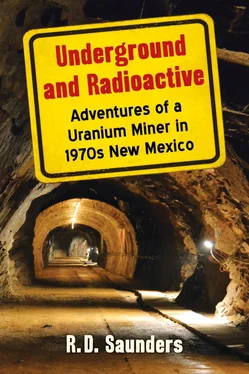Debris was a constant hazard, mostly due to falling rock, but sometimes from supplies left on the track by inexperienced laborers. As a result, derailed cars were a problem but something a good motorman could quickly remedy.
You might think that a motor with ten or more ore cars attached would make a lot of noise rolling down the track and would be easily heard. That wasn’t the case, though. With all the other ambient noise in a mine, a rolling motor was just peripheral sound that could easily be missed. Lights were therefore used in safety systems designed to keep workers from being run over by motors.
As a motor travels in reverse out of the station and into the mine through tunnels, called drifts, the motorman would come upon a series of lanyards hanging from the back at various intervals. Each time the motor passed under a lanyard, he was supposed pull it, setting off a series of lights flashing along the drift ahead warning anyone on the track that a motor was coming and to move quickly out of the way. Not a bad idea, but the flaws in that system were that bulbs did burn out and did not get replaced, and motormen in a hurry sometimes failed to pull the warning light lanyards.

Able to haul many tons of ore, these relatively small yet powerful machines were all electric so as to eliminate the smoke otherwise generated by an internal combustion engine. The battery covers are visible just behind the small operator’s cab (photograph by R.D. Saunders from an exhibit courtesy New Mexico Mining Museum).
Because drifts were commonly too narrow to accommodate the combined width of a worker and a motor, cutouts were put in at intervals along the track drifts. When workers walking down the track saw the lights above start flashing, they would quickly make their way to one of them. This system of lights also kept trains from colliding. As with many other safety systems underground, it was simple and effective. And, as with many of the safety systems underground, it was just as often ignored.
Experienced motormen were good about pulling those lanyards but not perfect. They sometimes overlooked the lanyards or, because they were speeding, missed them altogether. In anticipation of that eventuality, there was a second fallback system, the trip light.
Attached to the back of the last car on the motor was a small flashing light. This was not very bright but didn’t have to be because any light in total darkness is a lot of light. If they were working and the person on the track was paying attention at all, a trip light was hard to miss. The principal flaw of the trip light system was a dead battery and therefore no flashing light.
If a worker walking down the track was being alert, he would see the trip light in time to run to a cutout. Sometimes the worker would see it at the last moment, leaving just enough time to hop up on the coupling of the approaching car and ride it to safely when the motor came to a stop. What usually ensued afterward was a heated discussion between the motorman and the worker about safety. I rode many couplings during my time underground.
Occasionally a worker walking down a drift would not see the trip light, either because he wasn’t looking or because the light wasn’t working. In that case the worker was either hit or run over. Considering the safety systems used in running a motor, workers were hit a lot more than I would have expected.
I’m certain the powers that be weren’t too pleased when someone was hit by a motor, but the attitude among us underground was that it was too bad, but accidents do happen. Yes, the trip lights should have been working, and sure, the lanyards should have been pulled, and ideally a burned-out bulb should have been replaced. It’s a shame those things happened, but they did.
An additional flaw in the motor system was that sometimes people who shouldn’t have been operating them were operating them. I was one, but this also included many miners and miners’ helpers.

Trip light. Although in this example it is not, the light was attached to the rear of the last trip of ore cars proceeding into the mine. This safety device saved me from being run over a few times. Seeing the flashing light coming at me, I either ran the other way or jumped onto the coupling and went for a ride (photograph by R.D. Saunders from an exhibit courtesy New Mexico Mining Museum).
Because both miners and motormen got paid for cars of ore hauled, there was a delicate balancing act between motormen keeping miners happy by hauling ore and miners keeping their ore chutes full for the motormen. Often a miner would have a full chute of ore but no motorman around to empty the chute into ore cars. Something like that brings production to a halt for the affected miner, who is getting paid only for production, not by the hour. It was common practice for a miner or his helper to go get an idle motor and do the ore hauling himself. Basically what you had were a bunch of unqualified drivers on the track, which led to a lot of unpulled lanyards, dead trip lights, spilled ore, derailed cars, and more.
Motormen having their salary determined by the number of cars of ore hauled were not at all happy at the prospect of being assigned to hauling supplies, which paid them relatively little.
When it happened that a motorman had been assigned to haul supplies, he would be in a bad mood and in a big hurry to get the supply run finished. So while I was pretty happy about being able to accompany the supplies back into the mine, I usually did so with a grumpy motorman who wasn’t so happy about waiting around for some slow-moving, know-nothing greenhorn.
So began a regular routine for me of accompanying supplies back to working areas of the mine. I loved going back into those areas and getting a feel for it, and I can’t think of a single thing I didn’t like about that right from the start.
As I said, the motormen didn’t have any particular affection for either hauling supplies or for laborers in general and were not shy about withholding their displeasure. They were constantly on me to get the supplies on and off the motor as quickly as possible so they could go back to hauling the ore that made them money.
Upon reaching a delivery destination, what usually happened was that I would dump supplies along the track as fast as I could and as close to the manway and raise as I could.
The manway was a vertical passageway with a ladder, sometimes a very long ladder, leading to a production area called a stope . Usually, but not always, there was another vertical shaft called a raise next to the manway used only to lift supplies into the stope.
When I came to know some experienced miners, I started asking why the production areas were called stopes. Nobody knew, and I got a lot of unwanted attention for even asking such a thing, so I started looking around for any information I could find. My own feeling is that it is unclear exactly where the term originated, but it is likely to have come from hard-rock metal mining.
High-grade metals like gold and silver often are found in uneven, diagonal veins. As the miners follow the ore up, they do so in a series of steps. Gradually the area being mined assumes the shape of a flight of stairs. Stope then became a derivative of step .
On the other hand, I did a lot of stooping during my time underground, so for me the term stope could just as easily have been a variant of stoop .
Читать дальше














